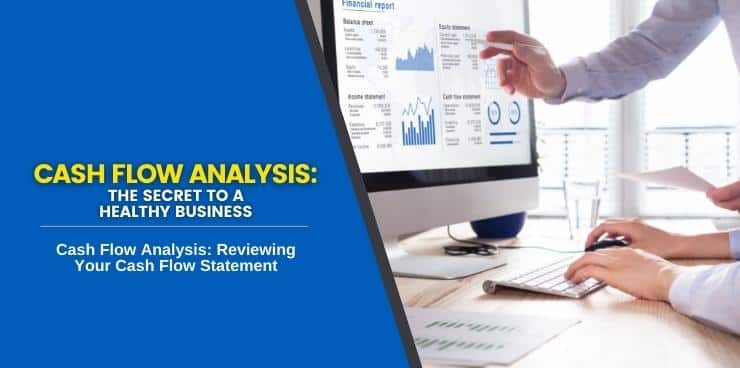Reviewing your business numbers means spending time on three financial statements:
- The P&L or income statement
- The balance sheet
- The cash flow statement
The three documents enable you to have a complete picture of your business’s financial health and standing. While reviewing the P&L and balance sheet is straightforward, the cash flow analysis can be slightly confusing. That’s because cash flow statements record the many changes in liquid cash of a business instead of absolute numbers.
From an accounting standpoint, the company may look profitable per the income statement. However, if accounts receivable go past due or turn up uncollected, you may face financial problems. Run out of cash, and you lose the ability to keep the business afloat. That’s why cash flow analysis is critical.
Cash flow analysis is the process of tracking, reviewing, and forecasting the in-and-out movement of cash in your business. By understanding cash flow analysis, you fully control how much money comes in, goes out and where they go.
In this article, we’ll deep dive into how to analyze the cash flow statement for your HVAC company. Keep reading.
Cash Flow Analysis Defined
The cash flow statement demonstrates how cash moves into and out of your business within a certain period. It can either be over a month or a quarter. The purpose of cash flow analysis is to know where your company’s cash comes from and where you’re allocating it. You can then use this information to see if you’re spending more than bringing cash in over time.
Business owners use the cash flow statement to complement the other financial statements. Together, these tell the complete story of your company’s financial health.
The balance sheet indicates what you own and what you owe. The income statement reveals your company’s profitability. The cash flow statement reviews your spending habits and tells you where you can cut costs.
Cash Flow Statement = Health of your HVAC Business?
We’ve already established that all financial statements gauge businesses’ overall health and standing. Still, looking at the cash flow helps assess a company’s short-term health and performance. Having cash on hand is a better runway than promises of accounts receivable. For instance, having readily available liquid cash allows your HVAC business to settle immediate bills and manage tech payrolls.
However, this fact seemed to be overlooked by HVAC contractors. Making a sale is not equivalent to siphoning payment to your bank account. Cash flow deals with the actual movement of liquid money within your business.
The goal is to maintain a positive cash flow. That is where proficient cash flow analysis comes in handy. If you’re looking for a finance expert to help you in this aspect, look no further. Wizard of Sales® has you covered. Book a call.
 How do you Perform Cash Flow Analysis?
How do you Perform Cash Flow Analysis?
Reading and analyzing a cash flow statement are two different things.
Analyzing information means interpreting the data and formulating a plan of action to improve the current situation. For HVAC businesses, you want to trim down all costs you could forego to boost your profits.
Moreover, you also want to find ways to bring in more money and keep it. Cash flow analysis can help on those fronts.
Below are five of the most common cash flow questions with explanations. These will help you understand and manage similar situations when you encounter them with your cash flow.
1. Why don’t I have more cash in the bank if my profits increase?
Say your HVAC company is doing well in sales, and you’re also sticking religiously to your budgets. Why then is your net change in cash not as bountiful as you’d expect it to be? What gives? There are three possible scenarios:
Customers haven’t physically paid your business yet
What remains one of the biggest confusions among companies is not differentiating between profit and cash. Even if the books say you made a profit, it doesn’t necessarily mean you generated cash in your bank account. Like most HVAC businesses that give an invoice, clients may take some time to pay their dues.
If that’s the case, visit your cash flow statement. Check under, “change in accounts receivable” and determine if the value is low or negative. If yes, customers haven’t completed the payment yet, even if your income statement counted them as a sale.
Adjustment in your “change in accounts payable”
Look in the “change in accounts payable” section of your cash flow statement. If the number exceeds your forecasted value, you paid more bills than initially planned. It’s not always a bad thing. After all, better to manage payables than have them stockpiled.
The thing is that when you pay bills, you affect your cash situation. Essentially, more bills paid equates to less cash on hand.
Adjustments in your “change in inventory”
The HVAC business has an inventory dependency. The number of units you have in storage depletes during HVAC installations. This could be the reason behind your low cash reserve.
Visit the “change in inventory” line in the cash flow. If the number is lower this season, you may need to buy more units to support sales.
2. Is a negative “change in accounts receivable” a good thing?
That depends. A negative amount in your cash flow statement’s “change in accounts receivable” means you sold more on credit than collecting money from customers. In other words, customers owe you money (indirectly) but haven’t paid you yet.
Is that a good thing? Quite possibly. It could mean your sales increased. However, clients haven’t returned your invoices with cold, hard cash.
However, it could be a bad thing if you’re delaying the collection. You need to double down on delinquent customers to ensure they pay their commitments in a timely manner.
Make sure you have enough cash to get by while waiting for customers to pay up.
3. Accounts payable increased more than expected. Should I be concerned?
That also depends. Like the negative change in accounts receivable, a spiked “change in accounts payable” section may either be good or bad.
Collecting more bills that need to be paid eventually may be wrong. That is especially true if they’re non-revenue-generating payables. However, it can be good to defer payments to strategic partners or take advantage of trade discounts and volume kickbacks.
For example, your HVAC company buys units in volume. When you exceed certain sales volumes, you get a kickback from your supplier. In this case, bulking up on inventory to get over a threshold could very well serve you, as long as you have the necessary cash reserves or credit.
For some, this may seem okay, but you have to ensure it doesn’t sacrifice your accessible cash to cover other expenses, like payroll. Still, keeping your payables and payment dates in check will keep your records clean and prevent possible interest expenses.
Just keep in mind that payables should ideally stick to (or below, when ideal) your forecasted value.
4. What does a positive figure in your cash flow’s “change in inventory” line mean?
A positive change in inventory written on your cash flow means you’ve sold more products than bought from suppliers. On the other hand, a negative number means you’ve stocked up more inventory than you’ve sold during the season.
Depending on the nature of the business, this could either be bad or good. For instance, HVAC businesses generally make more money in the summer when demand for repairs and installations is high. So, an HVAC business might stock up on inventory in the spring to cash in on the summer demand.
For comparison, in a grocery store, too much inventory could lead to expiration dates and, ultimately, wasted products. So, a grocery store would want to keep a close eye on its inventory levels to avoid overstock and shrinkage.
As a rule of thumb, businesses should always aim to have enough inventory to meet customer demand. However, not so much that it becomes a burden.
 5. What to do if the “net cash change” isn’t as favorable as expected?
5. What to do if the “net cash change” isn’t as favorable as expected?
The net cash change sums up all your HVAC business’s inflows and outflows. It’s the amount you added or subtracted to your initial bank balance before the accounting period. A positive net change in cash means growing your cash balance throughout the season. At the same time, a negative value means having less cash than you initially had.
If the value isn’t as favorable as you wanted, here are some items to look into:
Sales and expenses
This is where the relationship between cash flow and other financial statements comes in. Consider your sales and expenses from the income statement. Failure to meet your target revenue and operate below your budget expense can impact your balance. However, if you manage this well, the three options below will likely have the answer.
Accounts receivable
If your “change in accounts receivable” is negative, perhaps your clients don’t pay as fast as you’d like them to. Visit your balance sheet to see how much exactly customers owe you.
Accounts payable
You want your accounts payable to reflect what was originally forecasted. If the amount is lower, you may settle bills faster than planned. We recommend you slow down and stick to the forecast.
Inventory
You may have made excess inventory purchases that affected your cash balance. Your “change in inventory” section will reveal this.
Cash Flow Analysis Example
Consider the example below between two HVAC companies that displayed identical cash standings by the end of 2022. Let’s see which of them is experiencing more cash flow stress than the other.
| HVAC 1 | HVAC 2 | |
| 12/31/2022 | 12/31/2022 | |
| Operating Activities | ||
| Net Income | 250,000 | 250,000 |
| Additions to Cash | ||
| Depreciation | 30,000 | 240,000 |
| Gain on sale of equipment | (250,000) | 0 |
| Change in accounts receivable | (66,000) | 65,000 |
| Change in accounts payable | 17,000 | (11,500) |
| Change in taxes payable | (4,500) | (12,000) |
| Subtractions from Cash | ||
| Change in inventory | 55,000 | (120,000) |
| Net cash from operations: | 31,500 | 411,500 |
| Investing Activities | ||
| Sale of Equipment | 300,000 | (30,000) |
| Financing Activities | ||
| Notes payable | 40,000 | (10,000) |
| Beginning of year | 50,000 | 50,000 |
| CASH FLOW FOR F.Y. 2022 | 371,500 | 371,500 |
Despite starting with the same net income and ending with equal cash flow, HVAC 1 exhibits more signs of stress. The reason is that they’re not performing as well in terms of operating cash flow. The predominant increase in their cash reserve is the sale of equipment.
On the other hand, HVAC 2 is doing better from an operation standpoint. The cash flow from operations already amounts to $411,500. This means they don’t rely on one-and-done deals like the sale of equipment to generate cash.
The bottom line of your cash flow statement doesn’t tell the entire story. An in-depth cash flow analysis is required to fully gauge your short-term business health. In your HVAC business, you want to strengthen your core operating income to keep money coming in consistently.
If you need expert guidance on your cash flow analysis, book a call with Wizard of Sales®.


 How do you Perform Cash Flow Analysis?
How do you Perform Cash Flow Analysis?
 5. What to do if the “net cash change” isn’t as favorable as expected?
5. What to do if the “net cash change” isn’t as favorable as expected?